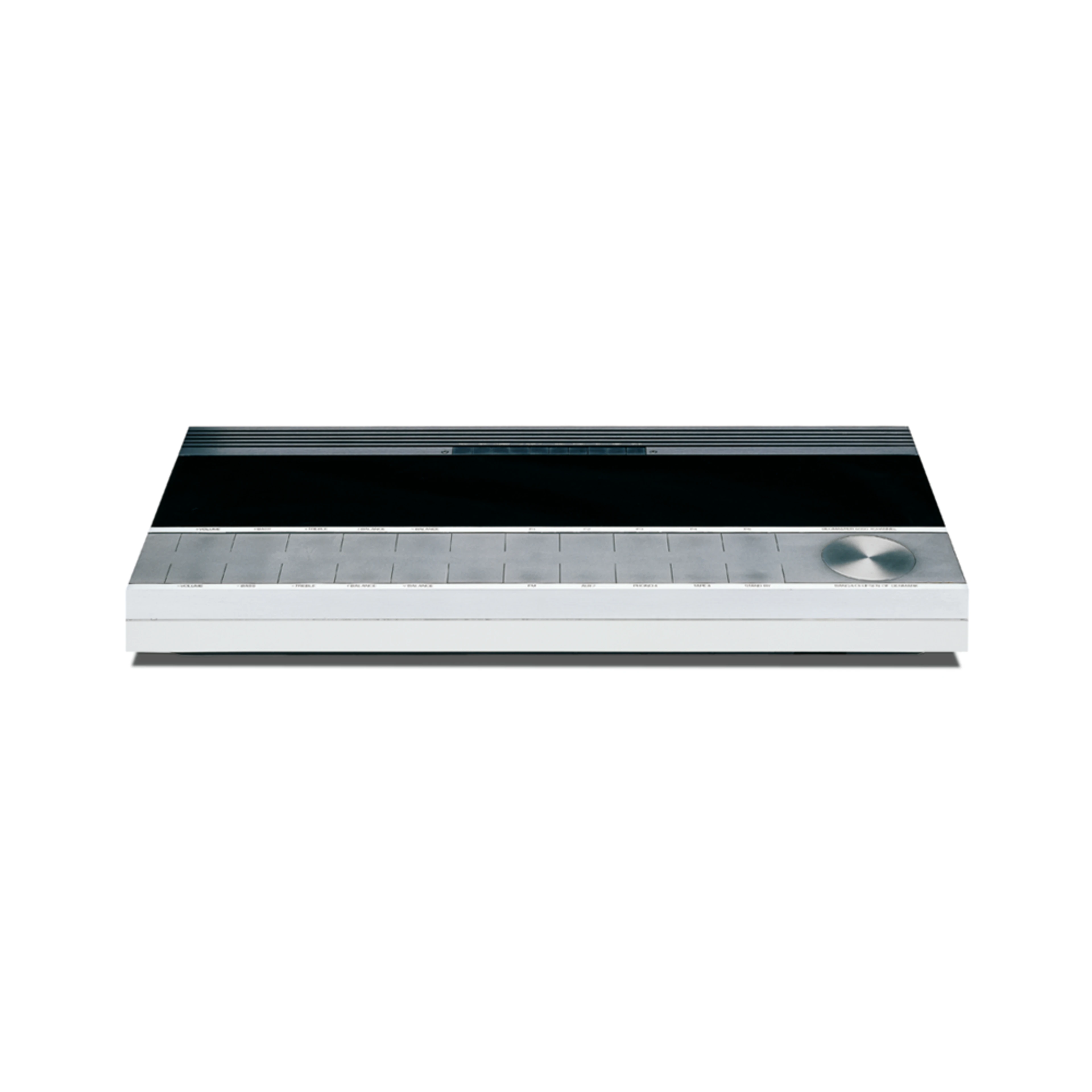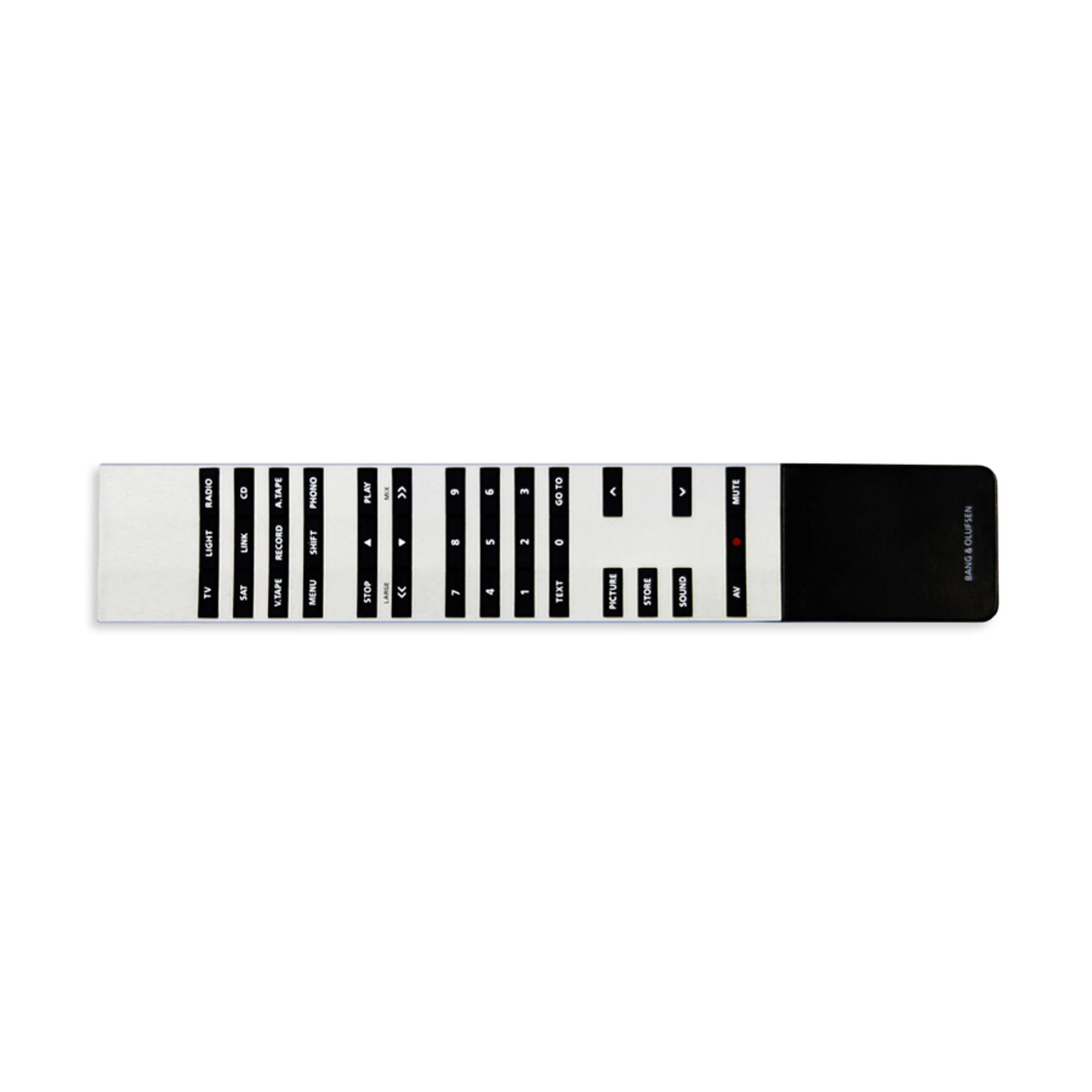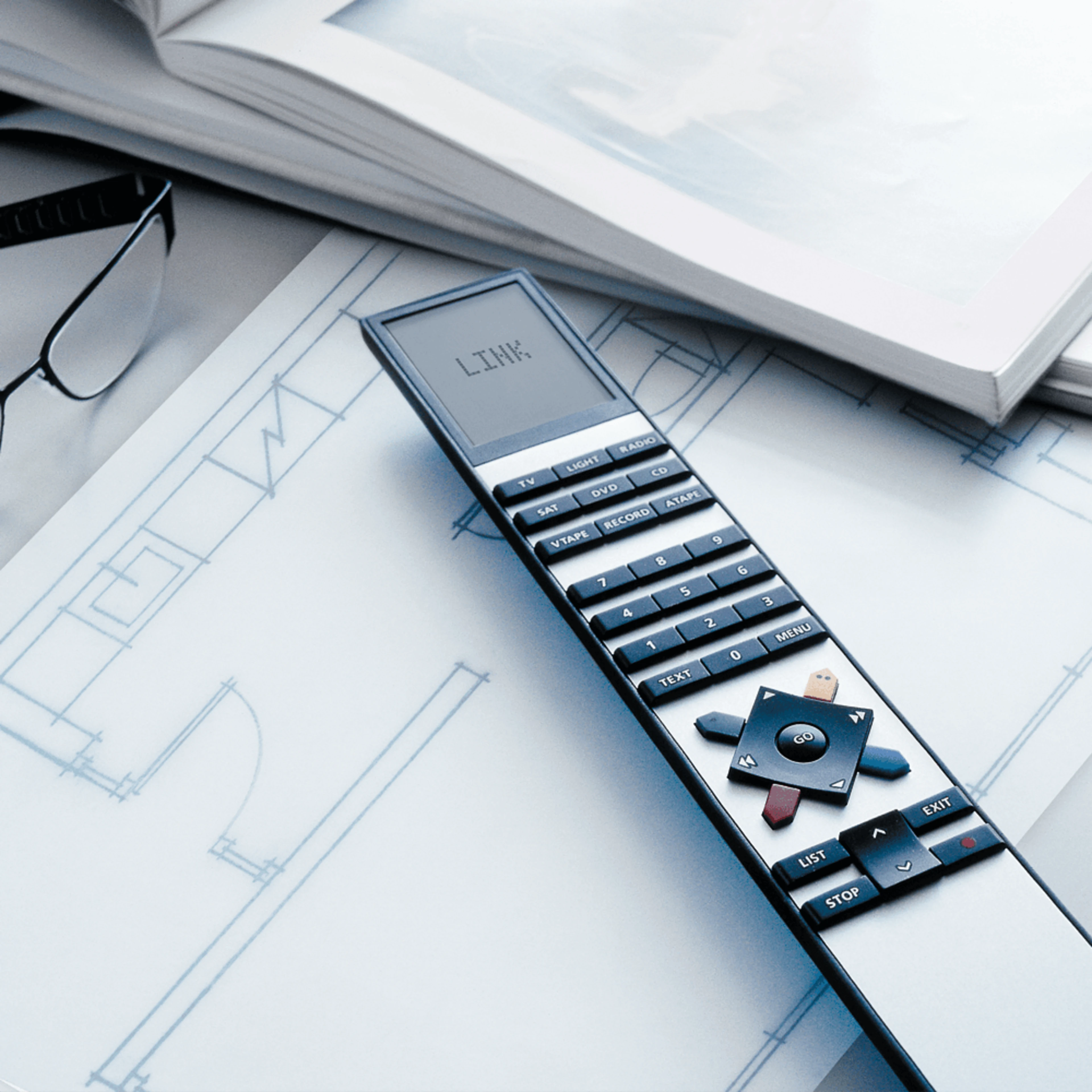La connexion entre vos enceintes
Beolink, c’est quoi ?
« Ce n’est que lorsque vous vous y êtes habitué et que vous le perdez soudainement que vous réalisez pleinement les avantages de Beolink » (par un technicien banc d’essai Bang & Olufsen)
From remote control to Beolink
The concept of linking was founded with the idea of adding remote control to your music system in the late 1970ies. Remotes for TVs were known, but Bang & Olufsen was the first to introduce remote operation of HiFi systems. Bang & Olufsen wanted to actively engage and empower people by putting the choice of sound and picture in the palm of your hand. All with the intention of offering the utmost opportunity to immerse yourself in the experience – from the comfort of your sofa. Bang & Olufsen’s very first foray into designing a remote control was as early as 1957. But it was not until 20 years later that the remote really gained a foothold.
Beomaster 6000
Beomaster 6000 (1974) was the first audio product using a 'commander'. It was unheard of to remote control a HiFi system and was almost considered sacrilege by HiFi enthusiasts. But to Bang & Olufsen, the remote operation was a question of putting audio and video control into the customer's hands.
AV-Remote
With the AV-remote (1986) – and the later extremely popular Beolink 1000 (1987) remote control – the audio and video operation merged, and Bang & Olufsen introduced the concept of one hand and one remote operation for all your sources in any room.
Integrated sources came first
Linking products started in 1979 with the integration of sources. Beocenter 7000 (1979) was one of the first. It combined and connected a gramophone, a tape recorder and a radio in one product – hence the name Beocenter – all operated by one remote.
With the introduction of Beocenter 7700 in 1982, a two-way remote that could operate all sources and get feedback in the display, using Master Control Link (later Beolink) – was officially launched, and now you could also distribute sound to up to four rooms. Still, the sound in all rooms was the same. Later it became possible to play different sources in different rooms at different sound levels.
One remote operation
In 1995, when most loudspeakers in the portfolio became active, Bang & Olufsen introduced Master Link. The idea behind this was straightforward: we thought that as you have light in every room, you should have music as well. In the early stages of Master Control Link, all rooms had to have the same volume level, but with Master Link, you could achieve complete freedom as every room could be controlled individually.
Touch TV in any room, and you would get TV sound. You could turn up or down the volume to different levels in different rooms. Touch radio, and you would get radio in your kitchen speakers although the radio was placed in the dining room.
One long press on standby would take the entire system – any product in any room – to standby. Complete control wherever you were in the house – all achieved with one remote.
The benefit for the customer was an effortless operation – you only had to understand one remote control to operate the entire system. Also, instead of filling up the house with products, you could fill up the place with music.
You had freedom of choice, as you could choose any Beolab speaker – large, small, floor standing, wall hanged. The conceptual idea was freedom of choice and 'clean up the mess'.
TV as part of the Beolink experience
Linking rooms was done by cabling the house with Master Link cables and adding a tiny IR receiver in the different rooms to use the remote control. TV became part of the Beolink experience by distributing video sources from one room to another, making the Bang & Olufsen offer unique in the market. The video signal was distributed using a coax cable, but sound control was handled via Master Link.
With the introduction of digital TVs, distribution of the video signal was abandoned, as it was not possible to get high-quality video performance in the link rooms. However, the distribution of sound from video sources continued.
Sound from the TV from both integrated (e.g., DVD player or TV sound) and connected sources (e.g., music system) could be shared in a Beolink setup. You could listen to the TV news from your living room TV in your bedroom, or you could playback content from, e.g., a CD player placed in another room on your TV speaker – as long as everything was connected via Master Link cables.
Basically, all products from Bang & Olufsen could be connected via the Beolink system.
From strictly B&O to open integration
For many years Beolink was a unique Bang & Olufsen proprietary system that allowed sound distribution between completely different speakers and televisions – however, using Bang & Olufsen branded products only. It was much more sophisticated than what the mass market 20 years later called multiroom but was challenged by being a proprietary system that did not integrate other brands.
At the beginning of 2001-02, the need for connecting non-Bang & Olufsen products increased. In 2002 this led to the development of the peripheral unit control (PUC). It was a system that added a small IR eye to any set-top-box – either DVD player, satellite box or CD player: This gave Bang & Olufsen operation via the remote control extending the possibility for connecting other brands to the Beolink system.
Setting the scene
Bang & Olufsen became increasingly aware of other intelligent systems in the market and entered into partnerships with some major home control providers within lighting and curtain control systems. As light and curtains are a natural part of the best cinematic experience, it was a natural next step to offer complete control from your Bang & Olufsen remote – setting the scene with light and curtains by pushing one button.
Simple light control had been part of the Beolink experience as early as in the Beolink 1000 remote in 1989 with Bang & Olufsen's own light control, but now a significant new step has been taken.
Over the years, the concept of home automation/smart-house or the intelligent home had spread rapidly to many of Bang & Olufsen's core customers, to whom simplicity and ease-of-operation matter. Besides experiencing the fantastic integration and control you have in a Master Link system with only one remote control, Bang & Olufsen decided to offer more benefits by providing a solution that integrated more seamlessly with other electronic equipment in the home as well.
This was made possible in 2009 with the introduction of the Master Link Gateway. The solution was introduced to the customers as a Beoliving experience. This was the codeword for a smart home solution thoroughly curated by Bang & Olufsen to a unique and tailored experience specified by what the customer was looking for – making life with the smart home uncomplicated.
Beolink 1000 (1987)
One of the hallmark remote controls of Bang & Olufsen was Beolink 1000 – it was founded on an idea of one remote operation of all you're A/V equipment. Many remotes came before Beolink 1000, but it was as if everything converged in this.
It was made out of zinc, a cool material to hold in your hand, and which gave you a robust and balanced feeling when holding it. Buttons were placed, so you could operate it without looking at it using only your thumb and holding it in one hand. When you buy a Bang & Olufsen product, the remote control is the only product you will touch extensively, so it needs to have that same exclusive feeling. Beolink 1000 was designed to last – and no matter how many times you dropped it on the floor, it did not break. It was popular as it was said it was child and dog-proof.
Beo4
It was replaced with Beo4 in 1994 – but even today, you will find Beolink 1000 in many homes around the world – working well as it has always done.
The remote control strategy of having one remote operation of all equipment has been a differentiating characteristic of Bang & Olufsen since it was launched. Making it into a luxury product that is robust and solid, has an operating range that outcompetes most other remotes has been a hallmark of remotes up until today's Beoremote One. One remote operation is a key element of the Bang & Olufsen Beolink strategy.
130 control commands per room - first Bang & Olufsen App
Via Master Link Gateway, customers were offered seamless control and operation of their home automation equipment from the Bang & Olufsen remote. In addition, Bang & Olufsen developed an App, so now you could control your equipment at home from your smartphone, even when you were at the office.
The Master Link Gateway allowed customers to combine home automation and A/V equipment; Switch on the light and the TV in the kitchen with a single touch on the remote control. Turn up the heat from your Bang & Olufsen App on your way home from the office. Activate your security system so when you arrive, the door is open, the lights are on, and music is playing in the hallway.
The operation was flexible as the Master Link Gateway allowed as many as 130 commands per room but curated to achieve a more straightforward operation for the customer. It could include local commands such as closing the curtains in one room to global commands like switching off the lights in the entire house.
Abandoning cabling of the house
Moving from analogue to digital was completed in 2015, where Bang & Olufsen introduced Network Link – the digital successor of the original Master Link. Opening the system into a LAN/Ethernet-Wi-Fi network allowed Bang & Olufsen to expand the possibilities such as multi-sources distribution, two-way control and to introduce a digital platform – but without the extensive cabling of the house that was necessary with Master Link. The Network Link concept in its pure form made it possible to distribute sound and link control to other rooms simply using standard Ethernet/Wi-Fi connections. Bang & Olufsen has realized the full transition from analogue to digital transmission of audio and later also high-quality (4k/8k) video.
The sky is the limit
Beolink SmartHome became the new buzz word, and once the door opened, a Bang & Olufsen system could integrate and operate any system – including systems not yet launched. Beolink was now all over the place; Beolink SmartHome added total integration between A/V products and smart devices like intelligent light switches, thermostat regulation, shade control, surveillance cameras, security systems etc. The experience was also extended from the Beoremote to include operation panels or switches where one button could hold a series of actions or scenarios – such as rolling down the curtains, switching on the TV, pulling down a projection screen, dimming down the light, turning on the DVD player – all by just pushing one button. The operation could also be moved to other devices; the mobile phone, tables, operation panels on the wall. A combination of a physical Beoremote and the Bang & Olufsen Beolink App on your phone took over. With this came the possibility to have remote operation of other locations – the summerhouse in France – all could be handled from the mobile phone, now using the mobile network in combination with your home network. Today's Beolink multiroom is a continuation of the original concept and is an integral part of most Bang & Olufsen products, now offering voice control and other exciting features that will continue to evolve.
The promise remains the same
There is a strong multiroom differentiation powered by Bang & Olufsen's long-standing commitment to connectivity and compatibility across technologies and platforms over time. Simplicity in operation with a one-touch philosophy yielding a simple approach to multiroom without being tied to a phone for daily music and operation. In this sense, Bang & Olufsen still enjoys a unique position.
Rejoignez la communauté Bang & Olufsen
Profitez de nouveaux produits en édition limitée, d’événements exclusifs, d’offres spéciales et de bien plus encore, en avant-première.



